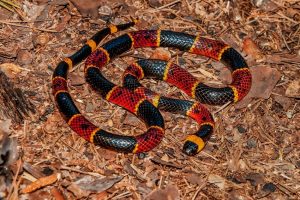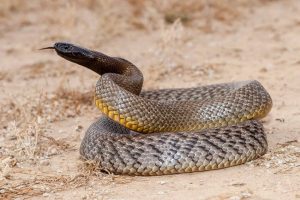The European Adder, also known as the Common Adder or Common European Viper, is the most widespread venomous snake in Europe today, with a distribution that spans across Europe and Asia. This snake is not particularly long, has a sturdy body, and can easily adapt to cold temperatures. They are even known to give birth during hibernation. Let’s explore this snake in this article from KnowAllAnimals!
Scientific classification
- Kingdom: Animalia
- Phylum: Chordata
- Class: Reptilia
- Order: Squamata
- Suborder: Serpentes
- Family: Viperidae
- Genus: Vipera
- Species: V. berus
1. A Little About the European Adder
The European Adder is a member of the Viperinae subfamily, which belongs to the family Viperidae. This subfamily is endemic to Europe, Asia, and Africa, and includes about 13 genera. They are sometimes called “pitless vipers” because, unlike their Crotalinae cousins (pit vipers), European Adders do not have heat-sensing pits between their nostrils and eyes.
The scientific name for this snake species comes from the Old English word “næddre.” Initially, this word was used to refer to any snake. Later, people applied it mainly to venomous snakes or snakes that looked venomous. Because of this, there are many snakes that are commonly called adders, even though they are not true European Adders.
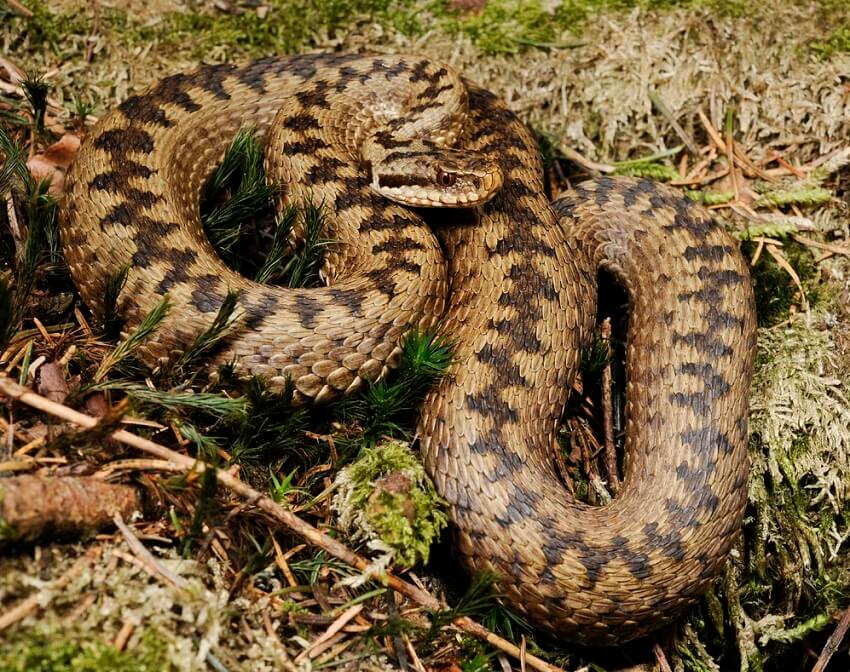
2. Where Do European Adders Live?
These snakes are widely distributed throughout Europe and Asia. They are found as far south as Greece, as far east as northern China, as far north as Scandinavia, and as far west as Britain.
The European Adder is the only snake species that lives above the Arctic Circle and is better adapted to the cold than other snakes. They spend up to 9 months a year hibernating, and females may only reproduce once every few years.
This snake species is terrestrial and spends most of its time on the ground, where it hunts ground-nesting birds and small mammals. However, they sometimes climb up on banks and small bushes to stalk or ambush prey.
European Adders typically hunt during the day. If you are walking along the edge of a forest or in the countryside, you can easily encounter this snake.
3. Physical Characteristics of the European Adder
The European Adder has a zigzag pattern running down its back and a V-shaped marking on the top of its head. This is one of the few snake species that is sexually dimorphic; females are brown, with a light brown base color, and males have a bright silver base color that makes the zigzag pattern stand out even more. This snake species has heavily keeled scales that give its skin a rough texture.
European Adders are relatively short and small, only growing to be about 2–5 feet long. Females are usually larger and longer than males. Newborns are about 3–5 inches long. The size of this snake varies depending on its habitat. The farther north they live, the smaller they are.
They are primarily terrestrial but sometimes climb up into small bushes or hills to bask in the sun or hunt. These snakes often hibernate during the cold months. The hibernation period can last up to 8–9 months. Many snakes do not survive the hibernation period, and the young are the most susceptible.
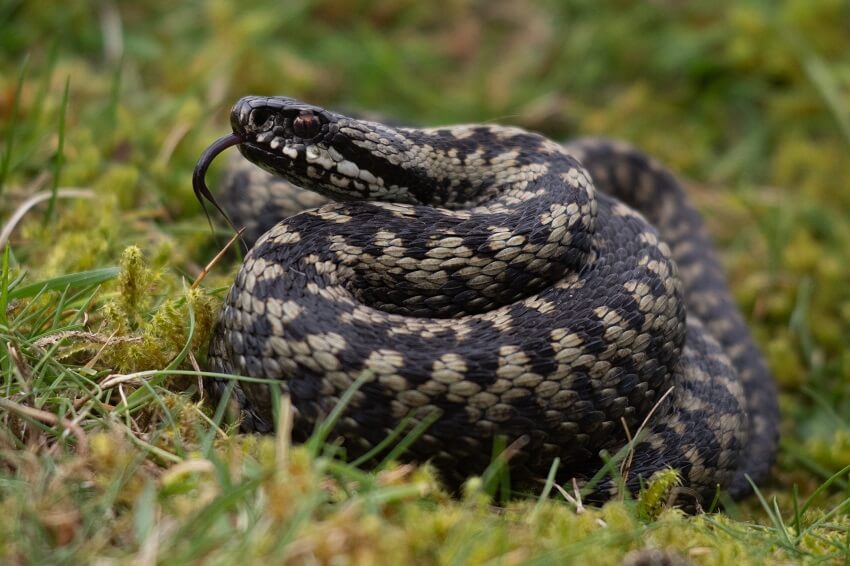
4. Behavioral Characteristics of the European Adder
These are shy snakes that will escape when they sense danger. Most bites occur when a snake is stepped on or picked up. Although the IUCN Red List does not consider them to be an endangered or threatened species, their greatest threats are habitat fragmentation and invasive wildlife.
Like many other snakes, they are a natural enemy of rodents and will try to avoid you if given the chance.
5. Types of European Adders
5.1. True Adders
This species is also called the true viper or pitless viper. They are endemic to Europe, Asia, and Africa. They have sharp and relatively long fangs. Those hollow fangs are connected to venom glands, which can be instantly lethal to any prey or perceived threat.
True adders include 90 species across 13 genera, including:
- Bush vipers (Atheris sp.): Found in sub-Saharan Africa’s tropical forests.
- Puff adders (Bitis sp.): Found in most of Africa and the southern Arabian Peninsula.
- Night adders (Causus sp.): Found in Africa.
- Horned adders (Cerastes sp.): Found from northeastern Africa across Arabia and into Iran.
- Saw-scaled vipers (Daboia sp.): Found in Pakistan and India, east to China, and other parts of East Asia.
- Saw-scaled vipers (Echis sp.): Found in Africa north of the equator, some parts of the Middle East, India, and Sri Lanka.
- McMahon’s viper (Eristicophis macmahonii): Found near the Iran, Afghanistan, and Pakistan borders in the deserts of Balochistan.
- Giant vipers (Macrovipera sp.): Found mainly in North Africa, the Middle East, and the Milos Islands in the Aegean Sea.
- Kenya mountain viper (Montatheris hindii): Endemic to Kenya, living at altitudes of 8,900-12,900 feet on Mount Kenya and the hill country of the Aberdare Range.
- Upland vipers (Montivipera sp.): Found in the Middle East.
- Lowland viper (Proatheris superciliaris): Found in southern Tanzania, Malawi, and Mozambique.
- False-horned vipers (Pseudocerastes sp.): Found from Egypt to Pakistan.
Palearctic vipers (Vipera sp.) are the most common. There are 21 species in this genus, and they are found in Britain and almost all of continental Europe (including the Arctic Circle), some islands in the Mediterranean and Aegean seas, northern Asia, northern Africa, and North Korea.
5.2. Other “Adders”
Some snake species share physical characteristics with true adders, even if they are not venomous—or even if they are venomous.
- Death Adder: One of the most common ambush predators in the world. They live in parts of Australia and are more closely related to cobras and coral snakes.
- Western hognose snake: Sometimes called the hognose adder because they flatten their bodies as a form of defense. They have a complex “playing dead” routine that they use to get away from predators. This snake is completely harmless to humans and is usually found in the southeastern United States.
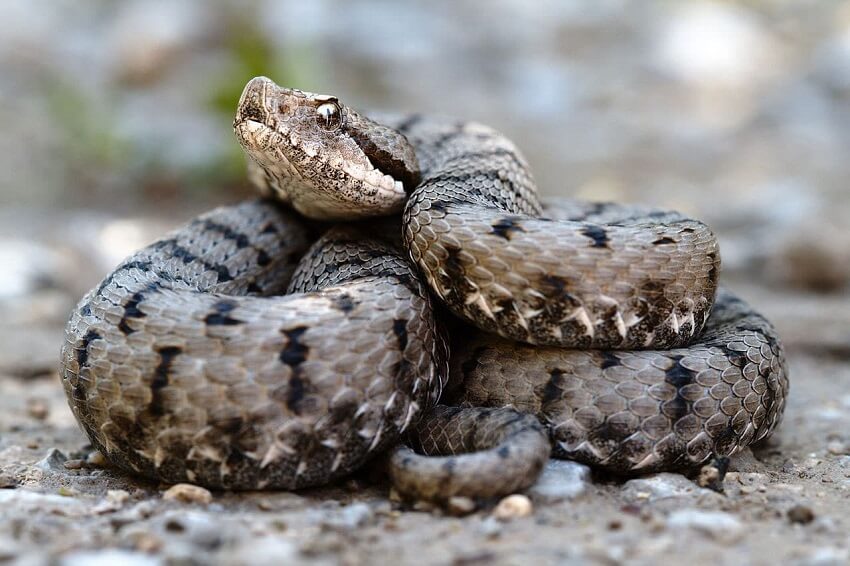
6. Population and Conservation Status of European Adders
Some subspecies of the European Adder are showing signs of a gradual decline and are predicted to be extinct within the next 12 years. However, other subspecies are classified as being of “Least Concern” in the Red List. Human deforestation for homes and production has affected the habitat of the European Adder, which is also a cause of their declining population. Additionally, in some areas, non-native wildlife also affects the stability of their population.
7. How Dangerous Are European Adders?
Like other viper species, the European Adder typically has hollow, hinged fangs connected to a venom gland, which functions like a hypodermic needle. When it bites, it injects venom into the victim (either a prey animal or in self-defense). Sometimes, it does not inject any venom at all, which is known as a “dry bite.”
Although a European Adder’s bite is venomous, it is not considered to be very dangerous. However, there are an increasing number of cases of European Adder bites due to people encroaching on their territory. Even so, in about 70% of bite cases, only a small fraction of people are in danger. Except for a very small number of cases that require hospital treatment, the effects of a bite, while unpleasant, are usually easy to treat. Deaths from a European Adder bite are extremely rare.
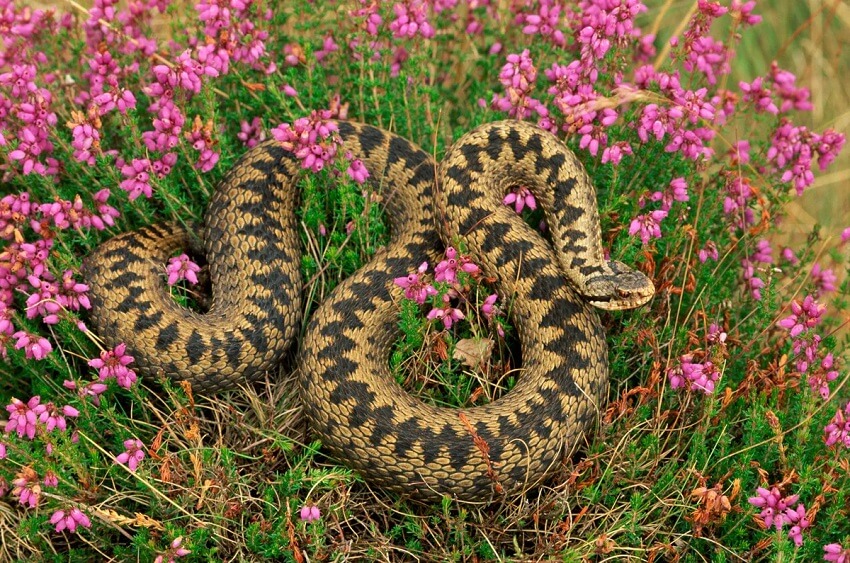
8. FAQs – Amazing Facts About European Adders
Unlike most other snakes, the European Adder is sexually dimorphic. The females tend to be brownish, and the males tend to be black and gray.
A few individual European Adders are a solid black color, and these are usually female.
Their young can stay near their mother for a few days after being born.
1. Are European Adders dangerous to humans?
Their bite is rarely fatal but can be painful and cause swelling, nausea, and other symptoms. Most bites occur when the snake is accidentally stepped on or handled.
2. Where are European Adders commonly found?
They inhabit a wide range across Europe, including the UK, Scandinavia, and parts of Central and Eastern Europe, typically in heathlands, woodlands, and grassy areas.
3. What do European Adders look like?
They are usually grey or brown with a distinct dark zigzag pattern along their back and a V- or X-shaped marking on the head. Adult adders typically grow to 60–80 cm in length.
This has been a summary of all the information about the European Adder that Know All Animals has shared with you. We hope this article has helped you better understand this unique snake.
References: https://en.wikipedia.org/wiki/Adder

